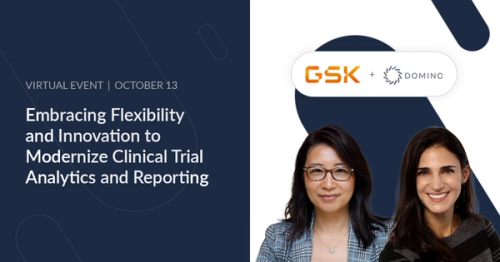How Janssen is Leveraging Data Science to Improve the Trajectory of Human Health
Domino2022-02-02 | 12 min read

When medical science meets data science, amazing things can happen.
Dr. Najat Khan – Chief Data Science Officer and Global Head, Strategy & Operations for Research & Development at the Janssen Pharmaceutical Companies of Johnson & Johnson and Co-Chair of the Johnson & Johnson Data Science Council – recently sat down with Thomas Robinson, Domino’s head of partnerships, to talk about the impact that data science can have on improving outcomes for patients and how organizations can most effectively unleash the power of data science.
During their discussion, Dr. Khan shared best practices for driving continuous improvement in data science, including the foundations and cultural changes needed to drive impact.
The following article is an edited transcript of the conversation, which took place during Domino’s virtual event on January 26, 2022, “Unleashing Exceptional Performance.”

Unleashing the Power of Data Science
Thomas Robinson: Thanks for joining us today.
Dr. Najat Khan: Thanks so much for having me here. It’s great to be here.
Thomas Robinson: Tell us about data science at J&J and how your team impacts J&J’s mission.
Dr. Najat Khan: The mission of data science at J&J is the same as our overarching mission: to improve the trajectory of human health. In the pharmaceutical sector, we are leveraging data science to improve the probability that a therapy or innovation becomes a transformational medicine for patients, and to do this better and faster. In the medical device sector as well as our consumer health sector, we use digital surgery, robotics, and customer-centric personalization to improve the experience and outcomes for our patients and customers. This is end-to-end across J&J.
Imagine a patient that has unfortunately been diagnosed with cancer. As we drive towards precision medicine, therapies are being developed that have better outcomes for patients with a specific mutation in their cancer. Now imagine that this patient has a specific mutation for which there is a targeted therapy – being able to deliver the right therapy for the right patient is the holy grail in medicine. However, currently, these mutations are not picked up in a routine way because they are new and therefore are not sequenced on a regular basis. But every patient gets their tumor biopsied – so what we have done is used data science to digitize those biopsy slides, and then we use machine learning model to predict what mutation a patient might have just from those images. The impact of that is to find – and find earlier – patients who could benefit from a targeted therapy and may otherwise have been missed. That translates to a significant impact for patients.
Collaboration as a Priority
Thomas Robinson: How do you engender collaboration in your teams?
Dr. Najat Khan: First, for every use case I always say, "Step back and make sure every single action is delivering something for a patient, no matter what your role or experience in on the team." This ensures everyone is serving a collective goal – which is especially true and important to a new discipline such as data science. If you stay in theory for too long, a lot of these new disciplines lose their steam because people say, "You can't apply it to healthcare." But you can, and we are.
The second is to ensure that data scientists and scientists or others in the field are co-citizens; they're sitting around the table ideating on what the problem is all the way through – iterating, interpreting the analysis, and executing. This is important because you don't want these emerging data science perspectives to get diluted. You need to have an inclusive culture in decision-making. Because if your input doesn't get to the decision-making point, then we haven't made true progress.
Third, it doesn't matter if you're a senior vice president or an analyst or you're inside the walls of Janssen or outside, a smart idea can come from anywhere. Having humility and open-mindedness is something I push a lot in my teams. That's the only way you truly collaborate, opening up to different ideas so that you are competing to win and serve the overall collective goal, not simply doing something because you're checking the box.
From Theory to Action to Impact
Thomas Robinson: How do you build the culture of your data science team and stakeholders, and manage change?
Dr. Najat Khan: When I first took on this role, a lot of people said, "Take a year, do a listening tour, build a strategy, build the foundations." All that is very important, but it's also important, early on, to move data science or any new discipline from theory to action to impact. You can't wait a year or two because by then, opportunities to have impact can pass you by.
I head up both the data science and strategy and operations teams for R&D at Janssen, which means I'm deeply immersed in the pipeline and the science with my colleagues. The pipeline is the engine that drives any pharmaceutical company. This is important because knowing your pipeline means you can say, “What are the priorities that are going to make a difference for the business outcome,” whether it's the COVID-19 vaccine or many other questions for rare and chronic diseases that we have in our pipeline. And then next, "How much of this can be solved using data science? What is feasible?"
You need a portfolio of short-term and long-term use cases, and it needs to be across a diverse set of opportunities because you don't know what's going to work. Solve the short-term use cases early on. That's what creates that momentum. It enables you to go from a “push” to an organizational “pull” for data science. People see that it's creating a difference and we are in the lead. Everybody likes to be part of the winning team, so the best way to get people to adopt data science is to do the hard work – pick the right problem, be resilient in solving it, and show concrete impact.
We also focus on bringing in bilingual talent – talent that's proficient in data science and medical science. That builds that credibility and connectivity needed with scientists and operations leads so you're working as one team and don't get siloed. I think that this type of true integration and being embedded is of critical importance. Finding bilingual talent isn't easy. The discipline is new, so you also have to develop talent. We have people who were more on the science side, who now are data scientists too, or data scientists that have picked up the scientific language. That is also critical to get that buy-in and traction in the organization.
Building a Foundation for Data Science at Scale
Thomas Robinson: What role does technology plays in accelerating the performance of your data science team?
Dr. Najat Khan: You have to have a really good end-to-end platform to do data science at scale and ensure the right internal and external collaboration happens.
Think about it like a house's foundation. Step one of that is datasets, which are generally very fragmented in any large organization. When I took on the role I said, “We need to look at all the different datasets we have, and not just put them in a data lake, but have them linked and connected in one place with datasets that are linked and curated, with reproducible models and applications all in one place – a GitHub of sorts.” This enables you to build the models that you need and ensure that they’re reproducible and easily accessible so that data scientists don't have to start from scratch. You need the right regulatory platforms, and you need to have the same platform where you can build all the applications so that it's not just data scientists using it, but all scientists.
We have an end-to-end platform, called med.ai, where we have integrated our preclinical and our real-world data: imaging, lab results, clinical trial data. We have over two terabytes of data in one place. The platform where we build models, Domino, has been one of the underpinnings of being able to scale. We went from 10 to probably 150 plus projects, and you can't do that unless you have a standardized way of having all the data, models, applications in one place. It's huge from a recruitment perspective because the one thing data scientists don't want to do is to use all their time searching for data, models, Excel sheets, and who they should talk to!
Increasing Model Velocity
Thomas Robinson: What advice would give executives and data science leaders to increase their model velocity?
Dr. Najat Khan: Start with asking, “What are you trying to solve?” You have to think about the business outcomes you're trying to achieve, and knowing the pipeline really well and having the strategy set is one of the starting points.
In parallel, you don't want to spend too much time on theory, you want to get to action. Take a couple of important challenges and solve them. We have done over 35 partnerships in the last year. At Janssen, we’re really big on finding the smartest idea, inside or outside. But you have to have a good team that's discerning on what good looks like. Building that team of bilingual data scientists, having that platform to be able to scale – all of that is important. But it first comes down to getting traction early on with a couple of quick wins that are done well and then using that momentum to build that across the organization.
Lastly, change management is hard so it's important for everyone–from data scientists all the way to the leadership–to stay resilient and stay the course. Every time you get distracted by something else, there’s a frictional cost. For leadership, if you're going to do this, mean it and lean in on a daily basis. It’s the same for data scientists. It's so easy to jump from one role to another, but to see something through, there's a certain sense of pride when your mission is to help patients. And that doesn't take a few months, that takes a little bit longer. It's more than the algorithm or the publication. But the reward is worth it. When that first patient gets diagnosed early because of something you did, there's nothing else that parallels that feeling.
Learn More
Watch the virtual event, “Unleashing exceptional performance,” with renowned surgeon, author, and performance improvement expert, Atul Gawande, and Dr. Najat Khan, Chief Data Science Officer and Global Head, Strategy & Operations for Research & Development at the Janssen Pharmaceutical Companies of Johnson & Johnson.
Domino Data Lab empowers the largest AI-driven enterprises to build and operate AI at scale. Domino’s Enterprise AI Platform unifies the flexibility AI teams want with the visibility and control the enterprise requires. Domino enables a repeatable and agile ML lifecycle for faster, responsible AI impact with lower costs. With Domino, global enterprises can develop better medicines, grow more productive crops, develop more competitive products, and more. Founded in 2013, Domino is backed by Sequoia Capital, Coatue Management, NVIDIA, Snowflake, and other leading investors.
RELATED TAGS
Subscribe to the Domino Newsletter
Receive data science tips and tutorials from leading Data Science leaders, right to your inbox.
By submitting this form you agree to receive communications from Domino related to products and services in accordance with Domino's privacy policy and may opt-out at anytime.



